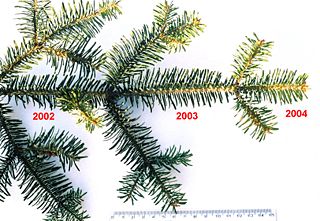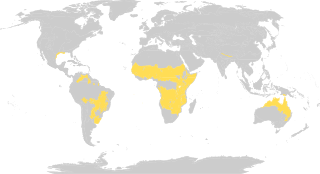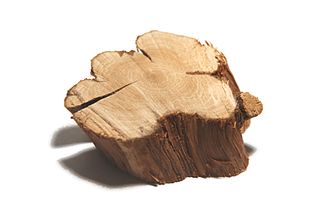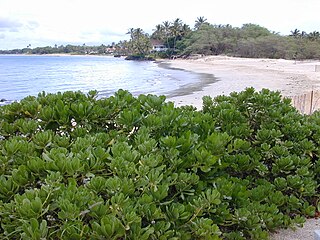
A biome is a biogeographical unit consisting of a biological community that has formed in response to the physical environment in which they are found and a shared regional climate. Biomes may span more than one continent. Biome is a broader term than habitat and can comprise a variety of habitats.

Begonia is a genus of perennial flowering plants in the family Begoniaceae. The genus contains more than 2,000 different plant species. The Begonias are native to moist subtropical and tropical climates. Some species are commonly grown indoors as ornamental houseplants in cooler climates. In cooler climates some species are cultivated outside in summertime for their bright colorful flowers, which have sepals but no petals.

In botany, an evergreen is a plant which has foliage that remains green and functional through more than one growing season. This contrasts with deciduous plants, which completely lose their foliage during the winter or dry season.

In the fields of horticulture and botany, the term deciduous means "falling off at maturity" and "tending to fall off", in reference to trees and shrubs that seasonally shed leaves, usually in the autumn; to the shedding of petals, after flowering; and to the shedding of ripe fruit. The antonym of deciduous in the botanical sense is evergreen.

Temperate grasslands, savannas, and shrublands is a terrestrial biome defined by the World Wide Fund for Nature. The predominant vegetation in this biome consists of grass and/or shrubs. The climate is temperate and ranges from semi-arid to semi-humid. The habitat type differs from tropical grasslands in the annual temperature regime as well as the types of species found here.

A savanna or savannah is a mixed woodland-grassland ecosystem characterised by the trees being sufficiently widely spaced so that the canopy does not close. The open canopy allows sufficient light to reach the ground to support an unbroken herbaceous layer consisting primarily of grasses. According to Britannica, there exists four savanna forms; savanna woodland where trees and shrubs form a light canopy, tree savanna with scattered trees and shrubs, shrub savanna with distributed shrubs, and grass savanna where trees and shrubs are mostly nonexistent.

Temperate coniferous forest is a terrestrial biome defined by the World Wide Fund for Nature. Temperate coniferous forests are found predominantly in areas with warm summers and cool winters, and vary in their kinds of plant life. In some, needleleaf trees dominate, while others are home primarily to broadleaf evergreen trees or a mix of both tree types. A separate habitat type, the tropical coniferous forests, occurs in more tropical climates.

Tropical and subtropical grasslands, savannas, and shrublands is a terrestrial biome defined by the World Wide Fund for Nature. The biome is dominated by grass and/or shrubs located in semi-arid to semi-humid climate regions of subtropical and tropical latitudes. Tropical grasslands are mainly found between 5 degrees and 15 degrees North and south of the Equator.

Tropical and subtropical moist broadleaf forests (TSMF), also known as tropical moist forest, is a subtropical and tropical forest habitat type defined by the World Wide Fund for Nature.

Lagerstroemia, commonly known as crape myrtle, is a genus of around 50 species of deciduous and evergreen trees and shrubs native to the Indian subcontinent, southeast Asia, northern Australia, and other parts of Oceania, cultivated in warmer climates around the world. It is a member of the family Lythraceae, which is also known as the loosestrife family. The genus is named after Swedish merchant Magnus von Lagerström, a director of the Swedish East India Company, who supplied Carl Linnaeus with plants he collected. These flowering trees are beautifully colored and are often planted both privately and commercially as ornamentals.

The subtropical zones or subtropics are geographical and climate zones to the north and south of the tropics. Geographically part of the temperate zones of both hemispheres, they cover the middle latitudes from 23°26′10.5″ (or 23.43624°) to approximately 35° north and south. The horse latitudes lie within this range.

Tropical climate is the first of the five major climate groups in the Köppen climate classification identified with the letter A. Tropical climates are defined by a monthly average temperature of 18 °C (64.4 °F) or higher in the coolest month, and feature hot temperatures all year-round. Annual precipitation is often abundant in tropical climates, and shows a seasonal rhythm but may have seasonal dryness to varying degrees. There are normally only two seasons in tropical climates, a wet season and a dry season. The annual temperature range in tropical climates is normally very small. Sunlight is intense in these climates.

A perennial plant or simply perennial is a plant that lives more than two years. The term is often used to differentiate a plant from shorter-lived annuals and biennials. The term is also widely used to distinguish plants with little or no woody growth from trees and shrubs, which are also technically perennials.

Rangelands are grasslands, shrublands, woodlands, wetlands, and deserts that are grazed by domestic livestock or wild animals. Types of rangelands include tallgrass and shortgrass prairies, desert grasslands and shrublands, woodlands, savannas, chaparrals, steppes, and tundras. Rangelands do not include forests lacking grazable understory vegetation, barren desert, farmland, or land covered by solid rock, concrete and/or glaciers.
Plant life-form schemes constitute a way of classifying plants alternatively to the ordinary species-genus-family scientific classification. In colloquial speech, plants may be classified as trees, shrubs, herbs, etc. The scientific use of life-form schemes emphasizes plant function in the ecosystem and that the same function or "adaptedness" to the environment may be achieved in a number of ways, i.e. plant species that are closely related phylogenetically may have widely different life-form, for example Adoxa moschatellina and Sambucus nigra are from the same family, but the former is a small herbaceous plant and the latter is a shrub or tree. Conversely, unrelated species may share a life-form through convergent evolution.

A woody plant is a plant that produces wood as its structural tissue and thus has a hard stem. In cold climates, woody plants further survive winter or dry season above ground, as opposed to herbaceous plants that die back to the ground until spring.

Solanum pyracanthos, also known as the porcupine tomato, is an evergreen shrub native to tropical Madagascar. It belongs to the genus Solanum, a diverse and cosmopolitan genus with over 1,500 species including the tomato, potato and nightshades.

Montane ecosystems are found on the slopes of mountains. The alpine climate in these regions strongly affects the ecosystem because temperatures fall as elevation increases, causing the ecosystem to stratify. This stratification is a crucial factor in shaping plant community, biodiversity, metabolic processes and ecosystem dynamics for montane ecosystems. Dense montane forests are common at moderate elevations, due to moderate temperatures and high rainfall. At higher elevations, the climate is harsher, with lower temperatures and higher winds, preventing the growth of trees and causing the plant community to transition to montane grasslands, shrublands or alpine tundra. Due to the unique climate conditions of montane ecosystems, they contain increased numbers of endemic species. Montane ecosystems also exhibit variation in ecosystem services, which include carbon storage and water supply.

Tropical vegetation is any vegetation in tropical latitudes. Plant life that occurs in climates that are warm year-round is in general more biologically diverse that in other latitudes. Some tropical areas may receive abundant rain the whole year round, but others have long dry seasons which last several months and may vary in length and intensity with geographic location. These seasonal droughts have great impact on the vegetation, such as in the Madagascar spiny forests. Rainforest vegetation is categorized by five layers. The top layer being the upper tree layer. Here you will find the largest and widest trees in all the forest. These trees tend to have very large canopy's so they can be fully exposed to sunlight. A layer below that is the middle tree layer. Here you will find more compact trees and vegetation. These trees tend to be more skinny as they are trying to gain any sunlight they can. The third layer is the lower tree area. These trees tend to be around five to ten meters high and tightly compacted. The trees found in the third layer are young trees trying to grow into the larger canopy trees. The fourth layer is the shrub layer beneath the tree canopy. This layer is mainly populated by sapling trees, shrubs, and seedlings. The fifth and final layer is the herb layer which is the forest floor. The forest floor is mainly bare except for various plants, mosses, and ferns. The forest floor is much more dense than above because of little sunlight and air movement.
Vegetation classification is the process of classifying and mapping the vegetation over an area of the earth's surface. Vegetation classification is often performed by state based agencies as part of land use, resource and environmental management. Many different methods of vegetation classification have been used. In general, there has been a shift from structural classification used by forestry for the mapping of timber resources, to floristic community mapping for biodiversity management. Whereas older forestry-based schemes considered factors such as height, species and density of the woody canopy, floristic community mapping shifts the emphasis onto ecological factors such as climate, soil type and floristic associations. Classification mapping is usually now done using geographic information systems (GIS) software.


















